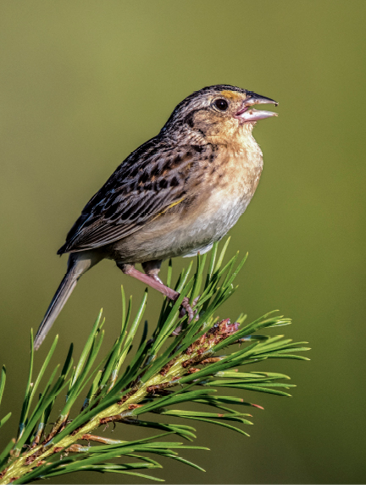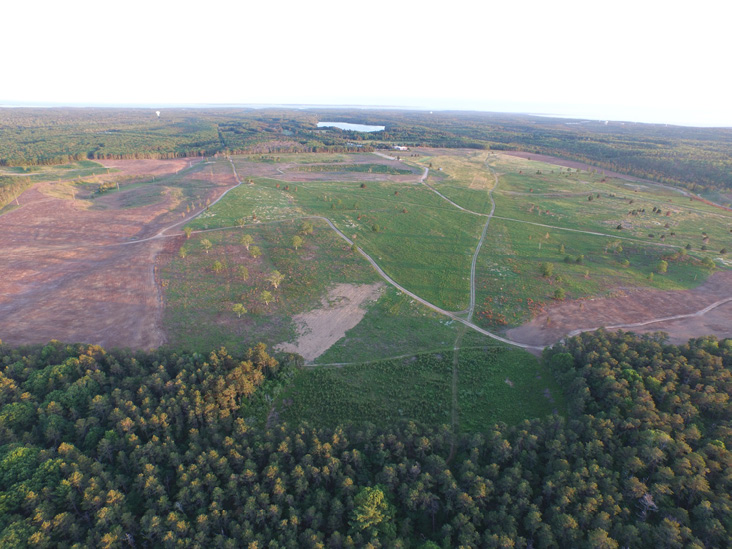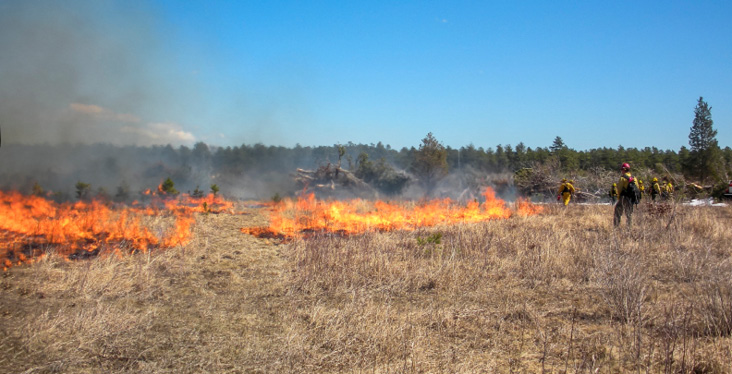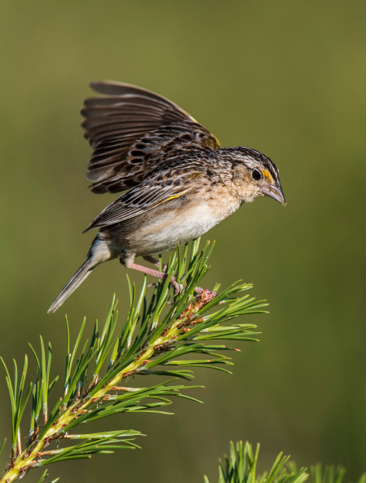Andrew Vitz and Chris Buelow

Grasshopper Sparrow at Frances A. Crane Wildlife Management Area. Photograph by MassWildlife/Bill Byrne.
Grassland birds represent one of the fastest declining suites of birds in North America, and for many species, these declines are occurring throughout their range. The once abundant grasslands associated with the Great Plains and parts of the Midwest have undergone a large-scale transformation to agricultural fields and pasture, and historical disturbances associated with grassland habitat, e.g., fire, have been largely removed from the landscape. In addition to habitat loss, fragmentation, and degradation, pesticide use has been implicated in playing a leading role in widespread declines of grassland birds in the United States (Mineau and Whiteside 2013).
Although the dominant natural habitat in Massachusetts is forest, grasslands have historically been present, especially along the coastal plain and in river valleys where sandy soils have been deposited by glacial activity and flooding. Following the last glacial period 10,000 years ago, the retreating ice left behind a barren landscape initially colonized by wind dispersed grasses and forbs. This early post-glacial revegetation likely resulted in contiguous grassland from the Great Plains to the New England coast. Grassland birds would certainly have benefitted from this increase in habitat, and it is thought that they have persisted in the region in pockets of habitat with sandy soils and periodic natural or anthropogenic disturbance such as fire (Vickery and Dunwiddie 1997). Support for the concept of a long-term grassland presence in New England is found in the evolution of northeastern endemic grassland-dependent birds such as the eastern subspecies of the Henslow's Sparrow (Ammodramus henslowii susurrans) and the Savannah Sparrow (Passerculus sandwichensis savanna).
 Grassland at Frances A. Crane Wildlife Management Area. Photograph by MassWildlife.
Grassland at Frances A. Crane Wildlife Management Area. Photograph by MassWildlife.
Habitat for many grassland birds in New England, including Grasshopper Sparrows (Ammodramus savannarum), increased following European colonization during the late 18th and early 19th centuries when approximately 80% of Massachusetts' forests were cleared for agriculture. In Birds of Massachusetts and other New England States, Edward Forbush referred to the species as "not so uncommon in Massachusetts as most people believe, but its insect-like song is barely audible at one hundred yards" (Forbush 1929). However, as farms in New England were abandoned, the land began to revert to forest resulting in declines of grassland birds. While this return to forest reflects a more natural state in the Northeast, it is important to remember that grassland habitats have been part of the Massachusetts landscape since the retreat of the Wisconsin Ice Sheet. In addition to forest regeneration, agricultural intensification in much of the remaining farmland has degraded the habitat for grassland birds, further contributing to their population declines.
As many native species associated with grassland habitat continue to decline, the regional viability of species such as the Grasshopper Sparrow has become tenuous. It is now generally recognized by conservation organizations, such as the Massachusetts Division of Fisheries and Wildlife (MassWildlife), Mass Audubon, The Trustees of Reservations (TTOR), and The Nature Conservancy, that managing grassland habitat in Massachusetts is a conservation priority. Furthermore, given the ongoing decline of Grasshopper Sparrow in the core of its range in the Great Plains and Midwest, managing for this species in the Northeast has increased in importance. Breeding Bird Survey results indicate the Grasshopper Sparrow has undergone a range-wide 2.5% annual decline since 1966, with an even steeper annual decline (-3.3%) throughout the New England and mid-Atlantic region (Sauer et al. 2017). As a result, the Grasshopper Sparrow is state-listed as either threatened or endangered in every New England state. Although the ephemeral nature of grasslands makes managing them a challenge, such management is necessary to maintain New England's full biodiversity.
The Grasshopper Sparrow is a small, migratory grassland bird with a relatively large breeding range extending from the western Great Plains to New England and a wintering range in the southern United States, Mexico, and the Caribbean. However the bird specializes in a habitat that is patchily distributed and rare throughout much of this range. Grasshopper Sparrows are considered to be area-sensitive and are generally only found nesting in suitable patches of habitat that are greater than 75 acres in size (Vickery 1996; MassWildlife unpublished data). In Massachusetts, nesting Grasshopper Sparrows are primarily found in grasslands dominated by warm-season bunch grasses. The species clutch size averages 4.3 eggs (range = 3–6), and it is capable of double brooding or producing two sets of young in a single breeding season (Vickery 1996). The female incubates eggs for 11–13 days and altricial young are fed in the nest for nine days before fledging. Upon leaving the nest, fledglings are flightless and for 3–4 weeks remain dependent on their parents before dispersing away from their natal territory (Vickery 1996). Although the Grasshopper Sparrow is subject to brood parasitism by the Brown-headed Cowbird, such parasitism levels are generally low and probably have little effect on the population.
Throughout New England, Grasshopper Sparrows are confined to a small number of sites, many of which are airports, landfills, and military installations. However, airport managers are increasingly compelled to reduce the amount of grassland habitat on their property as they seek to expand, maintain runway safety, and branch out into non-aeronautical uses. Similarly, at military sites, even though official policies recognize the need to take habitat needs into account, military uses take precedence over habitat concerns. Recently, efforts to encourage diversity in the energy sector have resulted in a push for solar panel installations in open habitats such as landfills and airfields, which adversely impacts grassland bird habitat at these sites.
Grasshopper Sparrows in Massachusetts
The Grasshopper Sparrow is listed as a threatened species under the Massachusetts Endangered Species Act (MESA). Through MESA, nesting habitat for this species is provided a layer of protection, and MassWildlife actively manages land to provide nesting habitat for this and other sandplain grassland species. Over the last several decades, Grasshopper Sparrows have been documented during the breeding period at 44 sites in Massachusetts, but almost half of these had only one or two singing males and many no longer support nesting birds. Only a few sites had more than 10 pairs of Grasshopper Sparrows, and sites with fewer than 10 pairs are highly vulnerable and frequently become locally extinct (Jones 2000).

Frances A. Crane Wildlife Management Area from a drone. Photograph by MassWildlife.
Suitable habitat can be created for Grasshopper Sparrows, but this process requires continued maintenance through prescribed burning, mowing, herbicide application, or low intensity grazing. Prescribed fire has been successfully implemented as a management tool in late summer and early fall or late winter and spring while avoiding habitat disturbance during the breeding season. Similarly, mowing during the breeding season has been documented to cause large scale nesting failure by grassland birds (Perlut et al. 2006), and a deferred mowing regime—after August 1—is recommended if managing for these species. One way to promote late-season mowing is to encourage the growth of native warm-season grasses (e.g., little blue stem, Indian grass), which mature later than the cool-season grasses, allowing for mowing to be delayed until after the peak nesting period.
In 2013, MassWildlife, in collaboration with conservation partners, developed "An Action Plan for the Conservation of State-listed Obligate Grassland Birds in Massachusetts" <https://www.mass.gov/service-details/grassland-bird-conservation>. Given concerns about the long-term viability of the Commonwealth's Grasshopper Sparrow and Upland Sandpiper (Bartramia longicauda) populations, the primary purposes of this report were to identify the most important breeding sites for these species and to initiate a long-term action planning and implementation process for top-ranking sites in order to enable the best possible management on an ongoing basis. Specifically, we sought to identify, and focus additional resources on the expansion, restoration, and management of Grasshopper Sparrow and Upland Sandpiper habitat on protected open-space sites that are large enough to support viable populations in the long-term and where grassland habitat management is a primary goal.
Of the 43 sites that were identified by the plan to have supported breeding Grasshopper Sparrows at some point since 1990, three sites, owned and managed by MassWildlife, were deemed to provide some of the best management and restoration opportunities in the state because of their positions in the landscape and the agency's commitment to managing these important resources. These sites were the Frances A. Crane Wildlife Management Area (WMA) in Falmouth, Southwick WMA in Southwick, and Bolton Flats WMA in Lancaster.
Frances A. Crane WMA: The grassland at Frances A. Crane WMA in Falmouth has long supported breeding Grasshopper Sparrows, but by the year 2000 the number of Grasshopper Sparrow territories had dwindled, primarily due to encroaching woody vegetation and a shift away from warm-season grasses. In 2001, a management regime was introduced to the grassland that included prescribed fire, targeted mowing, and invasive species control in order to begin restoring the sandplain grassland community. By 2004, the Grasshopper Sparrow population rebounded to nine territories, where it remained for several years with active management. In 2014, and based upon recommendations of the Grassland Bird Plan, MassWildlife began one of its most ambitious landscape restoration efforts in its history, working to nearly double the size of this grassland, bringing it to roughly 350 contiguous acres. This work focused on converting approximately 150 acres of woodland surrounding the existing grassland to grassland, planting this converted area with native warm-season grasses, and developing a management plan that would result in a high-integrity sandplain grassland community to support Grasshopper Sparrow and a large suite of other highly specialized—and often quite rare—plants and animals. The impact of this work on the Grasshopper Sparrow was almost immediate, with the population jumping to 27 territories in 2016, which is remarkable considering this increase occurred before any of the former woodland areas even supported grass. This increase in territories occurred on the original grassland footprint and was a result of simply pushing the forest edge back, allowing the original patch to become interior grassland habitat. As with many grassland birds, Grasshopper Sparrows strongly avoid edge habitat. By 2017, the new restoration areas began providing grassland habitat, and as these areas continue to improve, the Frances A. Crane WMA is expected to support approximately 50 Grasshopper Sparrow territories and become one of the largest and most stable sandplain grassland sites in Massachusetts.
Concurrent with MassWildlife's work at Frances A. Crane WMA, resource managers at the adjacent Joint Base Cape Cod also have recently increased their grassland restoration and management efforts, resulting in a marked increase in their Grasshopper Sparrow population. With these two sites in such close proximity (~1km), and with the goals of both programs so well aligned, the two agencies have begun working together to share expertise and resources. In fact, color-banded Grasshopper Sparrows have been detected moving between sites within a season, indicating the birds may actually perceive them as a single large grassland site.

Prescribed burn. Photograph by MassWildlife/Marianne Piche.
Southwick WMA: In 2008, MassWildlife purchased the former General Cigar Company property in Southwick. This approximately 250-acre parcel was predominately abandoned tobacco fields and was complemented by an additional 200 acres across the state line that was purchased at the same time by the Connecticut Department of Energy and Environmental Protection for the Suffield WMA. From the onset, these two properties were viewed as prime sites for grassland bird management due to their size, ability to support sandplain grassland community, and their proximity to two other important sandplain grassland sites: Westover Air Reserve Base in Chicopee, Massachusetts, and Westfield-Barnes Regional Airport in Westfield, Massachusetts. In fact, when purchased, both WMA properties supported small Grasshopper Sparrow populations, though the Southwick WMA population had disappeared by 2013 due to succession and the proliferation of invasive plant species. In 2015, and based upon the recommendations of the Grassland Bird Plan, MassWildlife initiated another ambitious grassland restoration effort aimed at maximizing the size and integrity of the sandplain grassland community at the Southwick WMA. This work focused on removing hedgerows, controlling invasive species, and restoring warm-season grasses across the site to create a contiguous, high quality grassland habitat of 250 acres, or about 400 acres when including the adjacent Suffield WMA. As with the Frances A. Crane WMA, the impact of the work at Southwick WMA was almost immediate. As the little bluestem became established in 2017, approximately 10 singing male Grasshopper Sparrows were documented on the site, along with strong numbers of Eastern Meadowlarks (Sturnella magna) and Savanna Sparrows (MassWildlife unpublished data). MassWildlife intends to introduce prescribed fire onto the site in 2018 and has just purchased an additional 80 acres adjacent to the existing grassland, some of which will be managed as grassland habitat.
Bolton Flats WMA: The core of the Pine Hills section of Bolton Flats WMA in Lancaster is a 130-acre former gravel mine that had traditionally supported a small population of Vesper Sparrows (Pooecetes gramineus), but had been succeeding to forest over the past decade. Based on this history, the size of the site, and its ability to support a sandplain grassland community, the Grassland Bird Plan identified the Pine Hills section of the WMA as the third opportunity for MassWildlife to actively manage for grassland birds on their properties. In 2014, the encroaching trees within the entire footprint of the former gravel mine were mowed, and by the summer of 2015 not only had a robust sandplain grassland community reestablished itself from the rootstock and seed bank, but Grasshopper and Vesper Sparrows quickly increased in numbers. Prescribed fire will be introduced in 2018 along with occasional targeted mowing to continue to push this toward a grass-dominated system.
Although these three wildlife management areas demonstrate successful Grasshopper Sparrow conservation, the majority of these birds in Massachusetts are found on military bases and municipal airports. MassWildlife works with staff at these sites to promote Grasshopper Sparrows and implement mitigation measures when applicable. The largest population of Grasshopper Sparrows occurs at the Westover Air Reserve Base in the Connecticut River Valley. The site is characterized by approximately 1,300 acres of grassland on well-drained sandy soils, and the habitat is managed through a combination of mowing and prescribed burns. In recent years, as part of an effort to encourage little bluestem, a native warm-season grass, the base has increased the use of prescribed burning and has begun employing a spring application of an herbicide and plant growth regulator that suppresses cool-season grasses. Exotic cool-season grasses grow quickly in spring requiring multiple mowings to keep the grass height low for aircraft safety concerns. Not only do native warm-season grasses allow for delayed mowing, but these bunch grasses provide ideal habitat for Grasshopper Sparrows as they offer the vegetative structure and bare ground necessary for foraging and nesting. In fact, grassland habitat in the form of hayfields generally does not support Grasshopper Sparrows because the vegetation is too dense. Given its large size and favorable management, Westover has been documented as supporting over 200 singing male Grasshopper Sparrows in recent years, making it the most important site for this species in all of New England (MassWildlife unpublished data).
Other Massachusetts sites that support substantial populations of Grasshopper Sparrow include the Westfield-Barnes and Plymouth airports. As with Westover, aircraft safety is a primary importance, and MassWildlife has worked with both airports to conserve Grasshopper Sparrows at these sites. At each site, surveys for Grasshopper Sparrows are conducted every couple of years, and a management plan has been implemented that will allow for aircraft safety and sparrow conservation. Municipal airports, military bases, and capped landfills provide important Grasshopper Sparrow sites in Massachusetts, and MassWildlife will continue to work with these organizations to conserve Grasshopper Sparrow populations through regulations provided by the Massachusetts Endangered Species Act.
Grasshopper Sparrows in other New England States
Compared to Massachusetts, the Grasshopper Sparrow is even more rare throughout the rest of New England. The more heavily forested states of Maine and New Hampshire do not support many nesting Grasshopper Sparrows, but the birds do remain at some managed grasslands, air fields, and landfills. In New Hampshire, the state-wide population of Grasshopper Sparrow is approximately 40 pairs. There are only three sites with more than five pairs of nesting Grasshopper Sparrows, and these are the Portsmouth International Airport at Pease, Concord Municipal Airport, and the Dillant-Hopkins Airport in Keene (P. Hunt, personal communication). Similarly, Maine has no more than five sites supporting nesting Grasshopper Sparrows, and these are all in the southeastern portion of the state. The 600-acre Kennebunk Plains complex in Kennebunk and the California Fields Wildlife Area in Hollis support most of the nesting Grasshopper Sparrows in Maine.

Grasshopper Sparrow at Frances A. Crane Wildlife Management Area. Photograph by MassWildlife/Bill Byrne.
In Vermont there are a limited number of sites in the agricultural area along Lake Champlain, and, according to eBird, during 2015–2017 the only multi-pair sites were the National Guard Camp Johnson in Colchester and the Franklin County State Airport in Swanton. Three other sites in Vermont had single observations of Grasshopper Sparrows. Rhode Island has only a single site—the Frances Carter Preserve in Charlestown—where Grasshopper Sparrows are reliable nesters. There are more nesting sites in Connecticut, with most of them being clustered within the Connecticut River valley. In addition to the Suffield WMA, multiple pairs of Grasshopper Sparrows are found at the Bradley International Airport in Windsor Locks, the Hartford Landfill, Rentschler Field in East Hartford, and Robertson Field in Plainville.
Because Grasshopper Sparrows require large patches of suitable habitat for nesting, conservation efforts targeting this species should benefit other grassland birds as well as species of concern in other taxonomic groups such as reptiles, invertebrates, and plants. For instance, the Frances A. Crane and Southwick WMAs and Westover Air Reserve Base all support nesting meadowlarks, with Westover hosting the most meadowlarks of any single site in Massachusetts. Other grasslands in Massachusetts that support important populations of nonlisted grassland birds include the Silvio O. Conte National Fish and Wildlife Refuge, the Common Pasture in Newburyport and Newbury, Woodsom Farm in Amesbury, and Mass Audubon's Daniel Webster Wildlife Sanctuary in Marshfield.
Conclusions
The Grasshopper Sparrow is state-listed as a threatened or endangered species throughout New England and is part of the region's natural heritage. The species is in urgent need of conservation, and its long-term persistence in the region is now largely dependent on anthropogenic management. Given that, it is up to conservation organizations to monitor and manage for this species to ensure its continued existence in New England. In Massachusetts, the state wildlife agency has partnered with other conservation-oriented organizations to promote Grasshopper Sparrow and other grassland bird populations, and the Massachusetts Endangered Species Act provides a layer of habitat protection in areas with nesting Grasshopper Sparrows. Together these actions lay the groundwork to maintain sustainable populations of Grasshopper Sparrows and ultimately the entire suite of grassland birds in Massachusetts.
Literature Cited
- Forbush, E.H. 1929. Birds of Massachusetts and Other New England States. Boston: Massachusetts Department of Agriculture.
- Jones, A. L. 2000. Grasshopper Sparrow metapopulation dynamics and conservation strategies in Massachusetts. M.S. Thesis. University of Massachusetts-Amherst.
- Mineau, P. and M. Whiteside. 2013. Pesticide acute toxicity is a better correlate of U.S. grassland bird declines than agricultural intensification. PLOS One 8(2):e57457. doi: 10.1371/journal.pone.0057457.
- Perlut, N.G., A. M. Strong, T. M. Donovan, and N.J. Buckley. 2006. Grassland songbirds in a dynamic management landscape: behavioral responses and management strategies. Ecological Applications 16: 2235–2247.
- Sauer, J. R., J. E. Hines, J. E. Fallon, K. L. Pardieck, D. J. Ziolkowski Jr., and W. A. Link. 2011. The North American Breeding Bird Survey, Results and Analysis 1966 - 2015. Version 2.07.2017. Laurel, Maryland: USGS Patuxent Wildlife Research Center.
- Vickery, P. D. 1996. Grasshopper Sparrow (Ammodramus savannarum), The Birds of North America Online (A. Poole, Ed.). Ithaca: Cornell Lab of Ornithology.
- Vickery, P. D. and P. W. Dunwiddie. 1997. Grasslands of Northeastern North America: Ecology and Conservation of Native and Agricultural Landscapes (Vickery and Dunwiddie, eds.). Lincoln: Massachusetts Audubon Society.
Andrew Vitz is the state ornithologist for the Massachusetts Division of Fisheries and Wildlife. He spent the summer of 1998 collecting data on the Florida Grasshopper Sparrow (subspecies) nesting success and population status. The principal investigator of the project was Dr. Peter Vickery of the Massachusetts Audubon Society, and on this project Andrew met his wife, Marja Bakermans. The Florida Grasshopper Sparrow is currently on the brink of extinction, and is now being captive reared by biologists trying to save the bird from the same fate as the Dusky Seaside Sparrow whose last known individual expired in captivity on June 17, 1987.
Chris Buelow is the restoration ecologist for the Massachusetts Natural Heritage and Endangered Species Program where he has focused on the restoration and management of rare species habitat and important natural communities across the Commonwealth for the past 15 years. Over this time, the relationship between sandplain grassland and the specialized species that these communities support— including Grasshopper Sparrow—has been a major aspect of his work. Chris is lifelong resident of Hardwick, Massachusetts, where he lives with his wife Jenna and daughter Vladia.